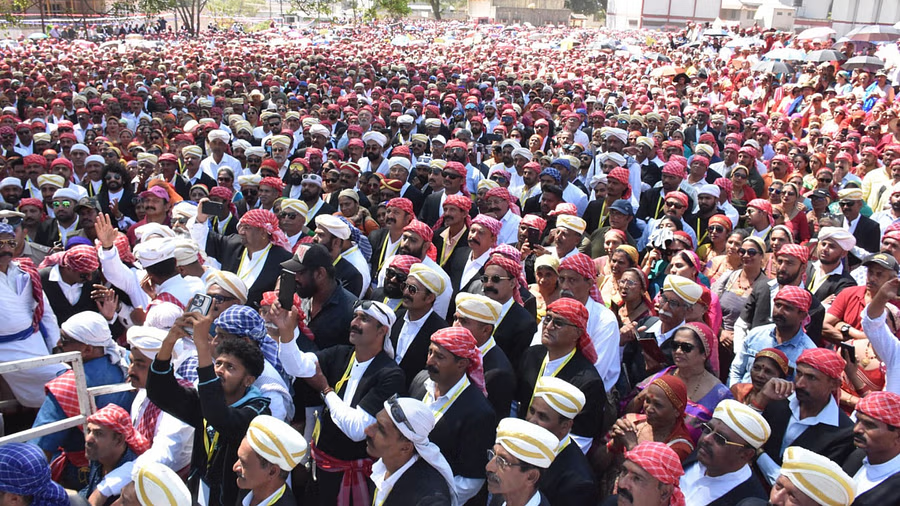This ‘journey by foot’ (kaal nadp) was called ‘Kodavaame Balo’ (‘May the Kodava way of living live on’). The participants walked through several towns over six days (from February 2 to 7).

Thousands of people at the march in Madikeri. / DH Photo by Rangaswamy / Credit: Special Arrangement
In the hills of Kodagu, a six-day walk was conducted, by Kodavas and other native Kodava speakers (Bhashikas), spanning 82 kilometres. Kodava is an endonym used by the natives of Kodagu, who were otherwise called ‘Kodaga’ in Kannada or ‘Coorg’ in English, and has two usages. One is for the language and culture followed by Kodagu’s indigenes and the other is for the most populous community among these people. Twenty one different communities speak the Kodava language.
People dressed in colourful attire walked from the southernmost town of Kodagu (Kutta) to the district headquarters (Madikeri). The men wore kuppya chele (a wraparound kurta and cummerbund) and mande vastra (head dresses). The women wore kodavathi podiya, sarees draped in the Kodava fashion. An incident at the Kattemad temple, where Kodavas in traditional dresses were denied entry, was the catalyst for the event.
This ‘journey by foot’ (kaal nadp) was called ‘Kodavaame Balo’ (‘May the Kodava way of living live on’). The participants walked through several towns over six days (from February 2 to 7). Lunch was provided by samajas (associations) along the route. At each village, the Kodavas and Kodava speakers such as the Ammas, Heggades, Kembattis and others, joined the procession from their homes. The Kodagu Muslims came out to greet and support the procession during the march.
The crowd was the largest on the final day. The main procession from South Kodagu covered 8.5 km from Kaggod until the Mand ground in Madikeri. Among those who walked from Kaggod was 82-year-old Maha Vir Chakra awardee Lt Col Puttichanda S Ganapathi.
Ajjinikanda Mahesh Nachaiah, president of the Karnataka Kodava Sahitya Akademi, walked along with me during the last day. He said, “A worldwide message has been sent that a community’s culture is their right which should not be hindered or opposed by others. An awareness has been created and this march will be remembered for years to come by our children and their generation.”
Historical and current significance
Even before the reign of the Haleri rajas (1600-1834), Kodava paddy agriculturists were living in Kodavu, now called Kodagu. They were employed in the army and the government. Some other castes employed in different professions also lived in Kodagu under the rajas. They spoke the same language and more or less followed the same culture.
During the 18th-century Anglo-Mysore Wars, Kodagu’s population was decimated. Many either died during the warfare or were deported as prisoners.
In 1834, the British took over Kodagu, renamed it Coorg, and made it a province. In 1947, it became part of independent India and, in 1950, it was one of the 28 states of the Indian Union. In 1956, Kodagu (Coorg) was merged with Karnataka.
The Kodavas speak a distinct Dravidian language. They worship their ancestors, nature, weapons and village deities such as Mahadeva, Povvadi and Ayyappa.
Kodagu lies between Kannada, Tulu, Tamil and Malayalam-speaking regions. Hence, along with the Kodagu distinctness, we see influences from these communities and cultures.
Key Demands
Bollajira Aiyappa, President of Codava Makkada Coota, who walked for two days, said, “This is the first time in history that all the Kodava and Kodava-speaking organisations came together. In the future as well, everybody should come together like this to solve problems.”
The event culminated with the President of the Akhila Kodava Samaja presenting the memorandum to the Deputy Commissioner, followed by lunch. On the final day, the organisers counted more than 30,000 lunch plates.
The main demand of the marchers was for the government to protect the Kodava identity, culture and constitutional rights.
source: http://www.deccanherald.com / Deccan Herald / Home> India> Karnataka / by Mookanda Kushalappa / February 13th, 2025

